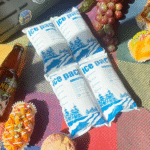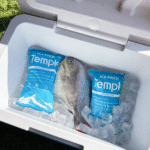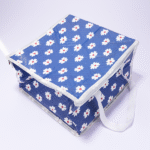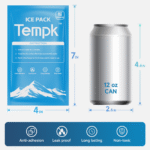Envío de mercancías perecederas, especialmente en la industria de la logística de la cadena de frío, Requiere una cuidadosa consideración del mejor método de enfriamiento.. Paquetes de hielo seco y gel. son los materiales más utilizados, cada uno tiene distintas ventajas. En este artículo, Exploraremos las diferencias entre estos dos agentes refrigerantes., guiarte sobre cuándo elegir cada uno, y discutir sus beneficios y limitaciones en función de la 2025 tendencias de envío de cadena de frío.
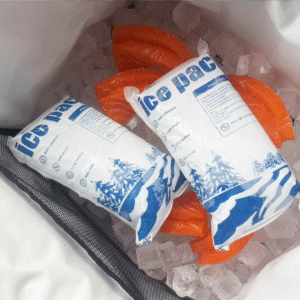
¿Qué son los paquetes de gel y hielo seco??
Hielo seco (Co₂ sólido):
El hielo seco es dióxido de carbono congelado que se sublima directamente de sólido a gas a -78,5°C. (-109.3°F), haciéndolo perfecto para ambientes extremadamente fríos. A diferencia del hielo tradicional, El hielo seco no deja residuos líquidos., Prevenir posibles daños por agua a productos sensibles..
Paquetes de gel:
Los paquetes de gel son recipientes flexibles llenos de un gel no tóxico., que se congela y libera frío gradualmente con el tiempo. Funcionan absorbiendo calor del ambiente circundante., mantener temperaturas típicamente en el rango de 2-8°C, ideal para productos refrigerados.
¿Cuándo debería utilizar hielo seco para el envío??
El hielo seco es la opción preferida cuando se envían productos que deben permanecer a temperaturas bajo cero., como productos farmacéuticos, muestras biológicas, o alimentos congelados. Su capacidad para soportar temperaturas extremadamente frías durante períodos prolongados lo hace ideal para envíos de larga distancia o envíos en climas cálidos..
Beneficios clave del hielo seco para el envío:
-
Frío extremo: Mantiene los artículos muy por debajo de -78,5°C, esencial para alimentos congelados y muestras médicas.
-
De larga duración: Se sublima lentamente, ofreciendo enfriamiento prolongado.
-
Sin residuos líquidos: Previene posibles daños al producto causados por la fusión..
Ejemplo práctico:
Una empresa farmacéutica que envía vacunas a todo el país puede preferir hielo seco para mantener las temperaturas ultrabajas necesarias durante el viaje..
¿Cuándo debería elegir paquetes de gel para el envío??
Los paquetes de gel funcionan mejor para productos que deben mantenerse frescos, Pero no congelado. Son ideales para productos sensibles a la temperatura como chocolates., productos cosméticos, y ciertos medicamentos. Los paquetes de gel ofrecen una forma más segura, alternativa no tóxica al hielo seco, y no requieren manipulación ni embalaje especializado.
Beneficios clave de los paquetes de gel para envíos:
-
Manejo seguro: Sin riesgo de quemaduras o asfixia., A diferencia del hielo seco.
-
Reutilizabilidad: Los paquetes de gel se pueden reutilizar, convirtiéndolos en una opción más rentable y respetuosa con el medio ambiente para envíos frecuentes.
-
Refrigeración personalizable: Los paquetes de gel se pueden adaptar para mantener rangos de temperatura específicos, como 2-8°C para productos farmacéuticos.
Paquetes de hielo seco vs gel: Comparación de pros y contras
| Característica | Hielo seco | Paquetes de gel |
|---|---|---|
| Rango de temperatura | -78.5°C (-109.3°F) | 2-8°C (32-46°F) |
| Duración del enfriamiento | De larga duración, puede durar días | Típicamente 12-48 horas |
| Manejo de seguridad | Requiere precaución (congelación, Acumulación de co₂) | Seguro, no tóxico |
| Embalaje | Requiere embalaje ventilado | No se necesita embalaje especial |
| Uso ideal | Alimentos congelados, productos farmaceuticos, muestras biológicas | bombones, productos cosméticos, electrónica sensible a la temperatura |
Cómo elegir entre paquetes de hielo seco y gel?
La decisión sobre qué agente refrigerante utilizar depende de varios factores., incluyendo los requisitos de temperatura del producto, la duración del envío, y los riesgos de manejo.
-
Requisitos de temperatura: Si el producto requiere congelación, El hielo seco es la única opción.. Para productos que necesitan permanecer fríos pero no congelados, Los paquetes de gel son la mejor opción..
-
Duración de envío: El hielo seco es mejor para envíos más largos, mientras que los paquetes de gel son ideales para períodos más cortos, envíos menos críticos.
-
Manejo de seguridad: Si su equipo no está equipado para manejar materiales peligrosos como hielo seco, Los paquetes de gel son una alternativa más segura..
2025 Tendencias de la cadena fría: Innovaciones y Sostenibilidad
A medida que evoluciona la industria de la cadena de frío, la sostenibilidad y la tecnología son cada vez más integrales. En 2025, Alternativas ecológicas a los métodos de refrigeración tradicionales., como paquetes de gel biodegradables y hielo seco de bajo PCA, están ganando popularidad. Embalaje inteligente, seguimiento de temperatura, Y las soluciones híbridas que combinan hielo seco y paquetes de gel también están surgiendo como métodos confiables para garantizar la integridad de los productos sensibles a la temperatura..
Tendencias clave para 2025:
-
Soluciones híbridas: Combinar hielo seco con paquetes de gel para extender la duración del enfriamiento.
-
Embalaje inteligente: Sensores integrados para seguimiento de temperatura en tiempo real.
-
Sostenibilidad: Mayor demanda de soluciones de refrigeración biodegradables y reutilizables.
Preguntas frecuentes:
Q1: ¿Qué es mejor para enviar productos sensibles a la temperatura?, Paquetes de hielo o gel?
El hielo seco es mejor para artículos congelados que requieren temperaturas ultrabajas, mientras que los paquetes de gel son ideales para productos que necesitan permanecer fríos pero no congelados.
Q2: ¿Cuánto tiempo pueden las bolsas de gel mantener la temperatura requerida??
Los paquetes de gel normalmente mantienen la temperatura durante 12 a 48 horas, dependiendo de su tamaño y composición refrescante.
Conclusión y recomendaciones
La elección entre paquetes de hielo seco y gel para el envío depende de la naturaleza de su producto., el rango de temperatura requerido, y la duración de su envío. El hielo seco es esencial para los productos ultrafríos, mientras que los paquetes de gel son más rentables y seguros para el frío, artículos no congelados. Para muchos envíos, Las soluciones híbridas que combinan ambos métodos pueden ofrecer los mejores resultados..
Siguientes pasos:
-
Evalúe sus productos: Identifique si es necesario congelarlos o simplemente mantenerlos frescos..
-
Utilice soluciones híbridas: Considere combinar paquetes de gel con una pequeña cantidad de hielo seco para envíos más largos.
-
Adoptar prácticas sostenibles: Explore paquetes de gel ecológicos o hielo seco de bajo PCA para reducir el impacto ambiental.
Acerca de Tempk
Tempk es un proveedor líder de soluciones sostenibles para la cadena de frío, Ofreciendo paquetes de hielo seco y gel para industrias que exigen un control de temperatura confiable.. Nuestras soluciones innovadoras garantizan que sus productos lleguen de forma segura y en óptimas condiciones.. Comuníquese hoy para obtener asesoramiento personalizado sobre sus necesidades de envío de cadena de frío.
















